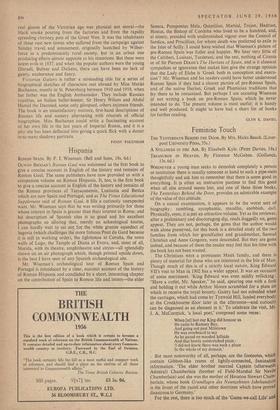Hispania
ROMAN SPAIN. By F. J. Wiseman. (Bell and Sons, 18s. 6d.) OLWEN BROGAN'S Roman Gaul was welcomed as the first book to give a concise account in English of the history and remains of Roman Gaul. The same publishers have now provided us with a companion volume on Roman Hispania. It, too, is the first book to give a concise account in English of the history and remains of the Roman provinces of Tarraconensis, Lusitania and Bmtica which are now Spain and Portugal, and as The Times Educational Supplement said of Roman Gaul, it fills a curiously unexpected want. Mr. Wiseman says that he was writing primarily for those whose interest in Spain is greater than their interest in Rome; and his description of Spanish sites is so good and his excellent photographs so alluring that, merely an achwological tourist, I can hardly wait to set out for the white granite aqueduct of Segovia (which challenges the more famous Pont du Gard because it is still in working order), the lighthouse at Corufia, the town walls of Lugo, the Temple of Diana at Evora, and, most of all, Merida, with its theatre, amphitheatre and circus—all splendidly shown on an air photograph which, though printed upside down, is the best I have seen of any Spanish archmological site.
Mr. Wiseman's archwological tour of Roman Spain and Portugal is introduced by a clear, succinct account of the history of Roman Hispania and concluded by a short, interesting chapter on the contribution of Spain to Roman life and letters—the elder Seneca, Pomponius Mela, Quintilian, Martial, Trajan, Hadrian, Hosius, the Bishop of Cordoba who lived to be a hundred, and, at ninety, presided with undiminished vigour over the Council of Sardica, and Priscillian, for whom death was preferred to exile in the Isles of Scilly. I could have wished that Wiseman's picture of pre-Roman Spain was fuller and happier. We hear very little of the Celtiberi, Lusitani, Turdetani, and the rest, nothing of Citania or of Sir Pierson Dixon's The Iberians of Spain, and is it classical sympathies or ignorance that makes him give the strange opinion that the Lady of Elche is 'Greek both in conception and execu- tion'? Mr. Wiseman and his readers•could have better understood Roman Spain if they had a clearer picture of pre-Roman Spain, and of the native Iberian, Greek and Phoenician traditions that lay there to be romanised. But perhaps I am accusing Wiseman of not writing a book on pre-Roman Spain, which he never intended to do. The present volume is most useful; it is handy and well produced. It ought to have had a short list of books for further reading.
GLYN E. DANIEL


































 Previous page
Previous page